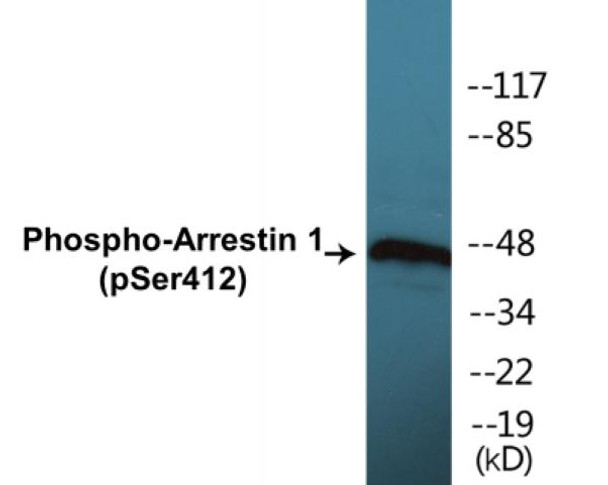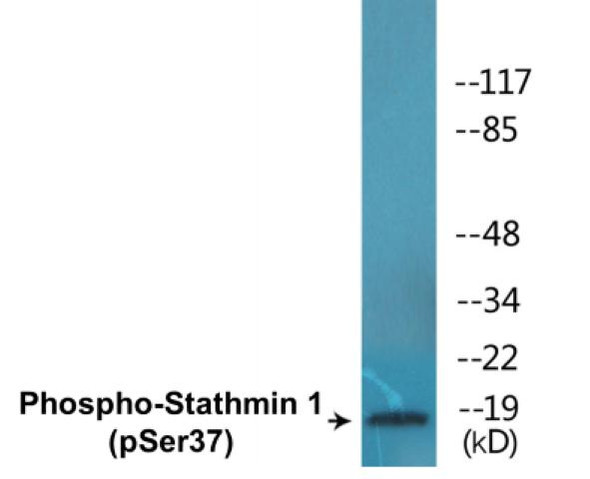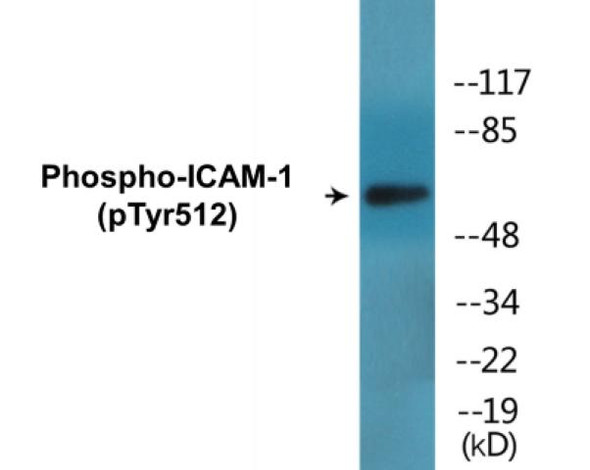Description
Arrestin 1 (Phospho-Ser412)Colorimetric Cell-Based ELISA Kit
The Arrestin-1 Phospho-Ser412 Colorimetric Cell-Based ELISA Kit is a highly sensitive and specific assay designed for the accurate detection of phosphorylated Arrestin-1 at Ser412 in cell samples. This kit offers reliable and reproducible results, making it ideal for researchers studying signaling pathways and cellular responses.Arrestin-1 is a key protein involved in regulation of G protein-coupled receptor signaling, playing a crucial role in processes such as receptor desensitization and internalization.
Phosphorylation of Arrestin-1 at Ser412 has been linked to various cellular functions and diseases, making it a valuable biomarker for understanding these processes and developing targeted therapies.With its easy-to-use format and efficient protocols, the Arrestin-1 Phospho-Ser412 Colorimetric Cell-Based ELISA Kit is an essential tool for researchers studying cell signaling, drug development, and disease mechanisms. Unlock new insights and drive groundbreaking discoveries with this innovative assay.
| Product Name: | Arrestin 1 (Phospho-Ser412)Colorimetric Cell-Based ELISA Kit |
| Product Code: | CBCAB01283 |
| ELISA Type: | Cell-Based |
| Target: | Arrestin 1 (Phospho-Ser412) |
| Reactivity: | Human |
| Dynamic Range: | > 5000 Cells |
| Detection Method: | Colorimetric 450 nm |
| Format: | 2 x 96-Well Microplates |
The Arrestin 1 (Phospho-Ser412) Colorimetric Cell-Based ELISA Kit is a convenient, lysate-free, high throughput and sensitive assay kit that can detect Arrestin 1 protein phosphorylation and expression profile in cells. The kit can be used for measuring the relative amounts of phosphorylated Arrestin 1 in cultured cells as well as screening for the effects that various treatments, inhibitors (ie. siRNA or chemicals), or activators have on Arrestin 1 phosphorylation.
Qualitative determination of Arrestin 1 (Phospho-Ser412) concentration is achieved by an indirect ELISA format. In essence, Arrestin 1 (Phospho-Ser412) is captured by Arrestin 1 (Phospho-Ser412)-specific primary (1ø) antibodies while the HRP-conjugated secondary (2ø) antibodies bind the Fc region of the 1ø antibody. Through this binding, the HRP enzyme conjugated to the 2ø antibody can catalyze a colorimetric reaction upon substrate addition. Due to the qualitative nature of the Cell-Based ELISA, multiple normalization methods are needed:
| 1. | A monoclonal antibody specific for human GAPDH is included to serve as an internal positive control in normalizing the target absorbance values. |
| 2. | Following the colorimetric measurement of HRP activity via substrate addition, the Crystal Violet whole-cell staining method may be used to determine cell density. After staining, the results can be analysed by normalizing the absorbance values to cell amounts, by which the plating difference can be adjusted. |
| Database Information: | Gene ID: 408, UniProt ID: P49407, OMIM: 107940, Unigene: Hs.503284/Hs.625320 |
| Gene Symbol: | ARRB1 |
| Sub Type: | Phospho |
| UniProt Protein Function: | ARRB1: regulates G-protein coupled receptors (GPCR) signaling by mediating both receptor desensitization and resensitization processes. Binds to GRK-phosphorylated receptor and sterically preclude its coupling to the cognate G- protein; the binding appears to require receptor determinants exposed only in the active receptor conformation. Targets many receptors for internalization by acting as endocytic adapters (CLASPs, clathrin-associated sorting proteins). Internalized arrestin-receptor complexes traffic to intracellular endosomes, where they remain uncoupled from G-proteins. Two different modes of arrestin-mediated internalization occur. Beta-arrestins function as multivalent adapter proteins that can switch the GPCR from a G-protein signaling mode that transmits short-lived signals from the plasma membrane via small molecule second messengers and ion channels to a beta-arrestin signaling mode that transmits a distinct set of signals that are initiated as the receptor internalizes and transits the intracellular compartment. Also involved in regulation of receptors other than GPCRs. Involved in Toll-like receptor and IL-1 receptor signaling through the interaction with TRAF6 which prevents TRAF6 autoubiquitination and oligomerization required for activation of NF-kappa-B and JUN. Binds phosphoinositides. Binds inositolhexakisphosphate (InsP6). Involved in IL8-mediated granule release in neutrophils. Interacts with phosphorylated ADRB2 and CHRM2. Interacts with SRC (via the SH3 domain and the protein kinase domain); the interaction is independent of the phosphorylation state of SRC C-terminus. Interacts with RAF1, CHUK, IKBKB and Nik. Interacts with DVL1 and DVL2; the interaction is enhanced by DVL phosphorylation. Interacts with IGF1R. Belongs to the arrestin family. 2 isoforms of the human protein are produced by alternative splicing. |
| UniProt Protein Details: | Protein type:Adaptor/scaffold Chromosomal Location of Human Ortholog: 11q13 Cellular Component: basolateral plasma membrane; chromatin; coated pit; cytoplasm; cytoplasmic vesicle; cytoplasmic vesicle membrane; cytosol; dendritic spine; Golgi membrane; heterotrimeric G-protein complex; lysosomal membrane; nucleoplasm; nucleus; plasma membrane; postsynaptic density; postsynaptic membrane; pseudopodium Molecular Function:alpha-1A adrenergic receptor binding; alpha-1B adrenergic receptor binding; angiotensin receptor binding; caspase inhibitor activity; enzyme inhibitor activity; estrogen receptor binding; follicle stimulating hormone receptor binding; GTPase activator activity; histone acetyltransferase activity; insulin-like growth factor receptor binding; mitogen-activated protein kinase kinase binding; protein binding; protein phosphorylated amino acid binding; transcription factor binding; ubiquitin protein ligase binding; V2 vasopressin receptor binding Biological Process: activation of MAPK activity; blood coagulation; follicle-stimulating hormone signaling pathway; G-protein coupled receptor internalization; inhibition of NF-kappaB transcription factor; negative regulation of caspase activity; negative regulation of interleukin-6 production; negative regulation of interleukin-8 production; negative regulation of protein ubiquitination; Notch signaling pathway; phototransduction; platelet activation; positive regulation of caspase activity; positive regulation of GTPase activity; positive regulation of histone acetylation; positive regulation of peptidyl-serine phosphorylation; positive regulation of protein amino acid phosphorylation; positive regulation of protein binding; positive regulation of protein ubiquitination; positive regulation of receptor internalization; positive regulation of Rho protein signal transduction; positive regulation of transcription from RNA polymerase II promoter; post-Golgi vesicle-mediated transport; proteasomal ubiquitin-dependent protein catabolic process; protein transport; protein ubiquitination; stress fiber formation; transcription from RNA polymerase II promoter |
| NCBI Summary: | Members of arrestin/beta-arrestin protein family are thought to participate in agonist-mediated desensitization of G-protein-coupled receptors and cause specific dampening of cellular responses to stimuli such as hormones, neurotransmitters, or sensory signals. Arrestin beta 1 is a cytosolic protein and acts as a cofactor in the beta-adrenergic receptor kinase (BARK) mediated desensitization of beta-adrenergic receptors. Besides the central nervous system, it is expressed at high levels in peripheral blood leukocytes, and thus the BARK/beta-arrestin system is believed to play a major role in regulating receptor-mediated immune functions. Alternatively spliced transcripts encoding different isoforms of arrestin beta 1 have been described. [provided by RefSeq, Jan 2011] |
| UniProt Code: | P49407 |
| NCBI GenInfo Identifier: | 20141238 |
| NCBI Gene ID: | 408 |
| NCBI Accession: | P49407.2 |
| UniProt Secondary Accession: | P49407,O75625, O75630, Q2PP20, Q9BTK8, B6V9G8, |
| UniProt Related Accession: | P49407 |
| Molecular Weight: | 46,309 Da |
| NCBI Full Name: | Beta-arrestin-1 |
| NCBI Synonym Full Names: | arrestin beta 1 |
| NCBI Official Symbol: | ARRB1 |
| NCBI Official Synonym Symbols: | ARB1; ARR1 |
| NCBI Protein Information: | beta-arrestin-1 |
| UniProt Protein Name: | Beta-arrestin-1 |
| UniProt Synonym Protein Names: | Arrestin beta-1 |
| Protein Family: | Beta-arrestin |
| UniProt Gene Name: | ARRB1 |
| UniProt Entry Name: | ARRB1_HUMAN |
| Component | Quantity |
| 96-Well Cell Culture Clear-Bottom Microplate | 2 plates |
| 10X TBS | 24 mL |
| Quenching Buffer | 24 mL |
| Blocking Buffer | 50 mL |
| 15X Wash Buffer | 50 mL |
| Primary Antibody Diluent | 12 mL |
| 100x Anti-Phospho Target Antibody | 60 µL |
| 100x Anti-Target Antibody | 60 µL |
| Anti-GAPDH Antibody | 60 µL |
| HRP-Conjugated Anti-Rabbit IgG Antibody | 12 mL |
| HRP-Conjugated Anti-Mouse IgG Antibody | 12 mL |
| SDS Solution | 12 mL |
| Stop Solution | 24 mL |
| Ready-to-Use Substrate | 12 mL |
| Crystal Violet Solution | 12 mL |
| Adhesive Plate Seals | 2 seals |
The following materials and/or equipment are NOT provided in this kit but are necessary to successfully conduct the experiment:
- Microplate reader able to measure absorbance at 450 nm and/or 595 nm for Crystal Violet Cell Staining (Optional)
- Micropipettes with capability of measuring volumes ranging from 1 µL to 1 ml
- 37% formaldehyde (Sigma Cat# F-8775) or formaldehyde from other sources
- Squirt bottle, manifold dispenser, multichannel pipette reservoir or automated microplate washer
- Graph paper or computer software capable of generating or displaying logarithmic functions
- Absorbent papers or vacuum aspirator
- Test tubes or microfuge tubes capable of storing ≥1 ml
- Poly-L-Lysine (Sigma Cat# P4832 for suspension cells)
- Orbital shaker (optional)
- Deionized or sterile water
*Note: Protocols are specific to each batch/lot. For the correct instructions please follow the protocol included in your kit.
| Step | Procedure |
| 1. | Seed 200 µL of 20,000 adherent cells in culture medium in each well of a 96-well plate. The plates included in the kit are sterile and treated for cell culture. For suspension cells and loosely attached cells, coat the plates with 100 µL of 10 µg/ml Poly-L-Lysine (not included) to each well of a 96-well plate for 30 minutes at 37 °C prior to adding cells. |
| 2. | Incubate the cells for overnight at 37 °C, 5% CO2. |
| 3. | Treat the cells as desired. |
| 4. | Remove the cell culture medium and rinse with 200 µL of 1x TBS, twice. |
| 5. | Fix the cells by incubating with 100 µL of Fixing Solution for 20 minutes at room temperature. The 4% formaldehyde is used for adherent cells and 8% formaldehyde is used for suspension cells and loosely attached cells. |
| 6. | Remove the Fixing Solution and wash the plate 3 times with 200 µL 1x Wash Buffer for five minutes each time with gentle shaking on the orbital shaker. The plate can be stored at 4 °C for a week. |
| 7. | Add 100 µL of Quenching Buffer and incubate for 20 minutes at room temperature. |
| 8. | Wash the plate 3 times with 1x Wash Buffer for 5 minutes each time. |
| 9. | Add 200 µL of Blocking Buffer and incubate for 1 hour at room temperature. |
| 10. | Wash 3 times with 200 µL of 1x Wash Buffer for 5 minutes each time. |
| 11. | Add 50 µL of 1x primary antibodies Anti-Arrestin 1 (Phospho-Ser412) Antibody, Anti-Arrestin 1 Antibody and/or Anti-GAPDH Antibody) to the corresponding wells, cover with Parafilm and incubate for 16 hours (overnight) at 4 °C. If the target expression is known to be high, incubate for 2 hours at room temperature. |
| 12. | Wash 3 times with 200 µL of 1x Wash Buffer for 5 minutes each time. |
| 13. | Add 50 µL of 1x secondary antibodies (HRP-Conjugated AntiRabbit IgG Antibody or HRP-Conjugated Anti-Mouse IgG Antibody) to corresponding wells and incubate for 1.5 hours at room temperature. |
| 14. | Wash 3 times with 200 µL of 1x Wash Buffer for 5 minutes each time. |
| 15. | Add 50 µL of Ready-to-Use Substrate to each well and incubate for 30 minutes at room temperature in the dark. |
| 16. | Add 50 µL of Stop Solution to each well and read OD at 450 nm immediately using the microplate reader. |
(Additional Crystal Violet staining may be performed if desired – details of this may be found in the kit technical manual.)






